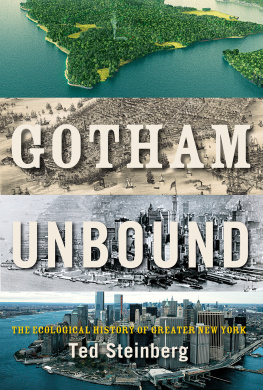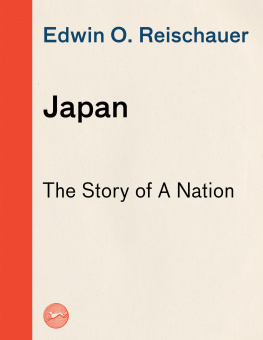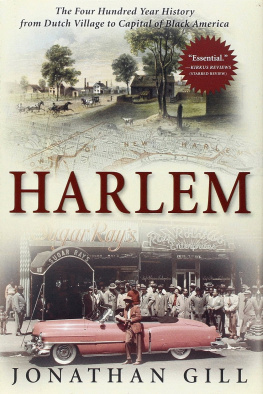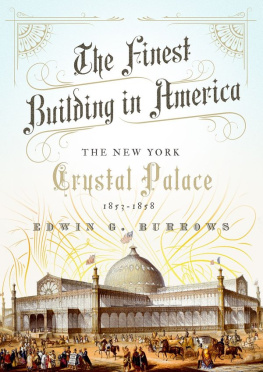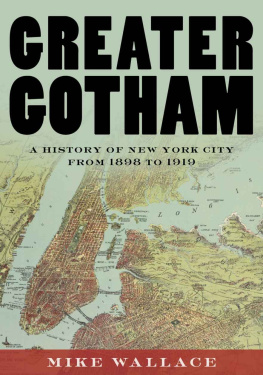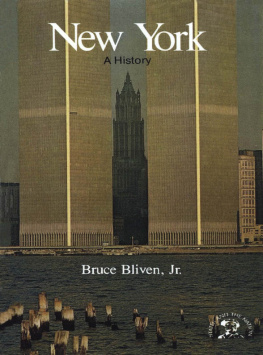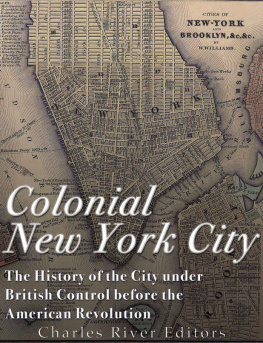Acknowledgments
One measure of how long this project has gone on is that so many of the people we most wanted to read the finished product are no longer around to do so.
For EGB that list includes my grandmother, Eleanor Gary Lemon, as well as my grandfathers, Prof. Millar Burrows of Yale University and the Rev. William Philip Lemon, scholars as well as men of faith, each of whom had set aside a place on his shelves for such a book as Gotham. I am sorry that Gerard Mutsaers, a Dutchman who took such pride in escorting friends around the Netherlands, did not live long enough to read about the role of his native country in the citys early history.
Among the family members whose absence I (MW) most regret are my mother, Margaret Wallace (I miss her joyful curiosity and unflagging support), my father, Aaron Wallace (I miss his wit and political empathy), and my uncle, Sol Isaacs (who, until his death at ninety-five, was still sharing laser-sharp memories of life as a New York garment presser and union man). Among mentors and friends I wish were here to share the satisfaction are Richard Hofstadter, a man who asked big questions and answered them with artistry and authority; Joe Murphy, former CUNY chancellor, crusader for working class educational opportunity and a strong supporter of this book; Herb Gutman, Raphael Samuel, Warren Susman, and Edward Thompsonmodel activist intellectuals all; and Tony Lukas, David Varas, and Elliot Willensky, who were looking forward to Gotham but departed way before their time.
Happily, there are vast numbers still around to share our delight and receive our thanks, beginning with those closest to us, those whove endured The Book, helped us to survive it, andmainlyshared and enriched our lives.
There is no one to whom I (EGB) am more beholden for firm anchorage and steady encouragement than my wife, Pat Adamski. Our life together began more than two decades ago with a rollicking late-night jaunt up Fifth Avenue, and it was during one of our many subsequent urban reconnaissances that I decided to launch a course at Brooklyn College on the history of the city. I am humbled by the thought that even while building her own distinguished career as a legal scholar and educator, she also found the time and energy to bear with me during the years that followed, as Gotham struggled toward completion. There are no words to encompass my wonder at the loving patience of our children, Matt and Kate, who have waited their entire lives for daddys book to be done, unaware of how many times their presence revived my spirits and kept me going until it was, in fact, done. My parents, E. G. Burrows and Gwenyth L. Burrows, not only brought me up to value good books and good writing but seemed to understand why Gotham required so long to finish. I am much obliged as well to Eric McKitrick and Richard Hofstadter, my teachers at Columbia University, whose guidance, praise, and friendship made all the difference to a young graduate student.
My (MW) wife, Hope Cookewise counsellor, historical compeer, voluptuous playmate (for the full encomium see my Mickey Mouse and Other Essays on American Memory)shared my love of the city and pleasure in exploring its past and present. Hope also provided me with a new familyHope Leezum, Palden, and Kesang, and now our grandchildren, Khendum and Diki. My sister, Penny, offered sibling love and helped keep me laughing. Anne Leiner was my wise, caring, and transformative counsellor. Marion Skelly and Lauree Wise were skillful healers when mind-and-body flagged. My old friend Bob Padgug has been waiting for this book as long as he can remember. Finally, some long overdue thanks to a trio of teachersEric McKitrick, who among other lessons taught me I didnt yet know how to write; Jim Shenton, who through example and exhortation got me into the history business; and Walter Metzger, who one day, without realizing it, broached the concept of a life project.
Its quite insufficient to thank Frances Goldin for being our agent. She is as much a principal in this project as we arethird paddle in our canoe. Frances is, to be sure, a superb literary representative, but her personal steadfastness and politically principled support were as important as her skillfulness. Without her deep caring, astonishing patience, and resolute determination this book would not likely have seen the light of day.
Many mavens helped us negotiate the churning currents of the big citys publishing industry. Vincent Virga, novelist, historian, and photo editor par excellence, was our crucial pillar and counsellor during many critical moments. The late Jerry Kaplan understood immediately what we wanted to do and opened the first of what would be many doors. Andre Schiffrin and Peter Dimock provided wise tactical and strategic advice. David Klein, Robert Youdelman, Leon Friedman, Bardyl Tirana, and Kellis Parker helped steer us through some legal rapids. Eddie Ellis offered the fruits of his encyclopedic labor and much of his library. Marty Duberman pointed us to Frances, and Sydelle Kramer, Francess associate, pointed out a productive path at a fork in the road. We thank too those in the publishing world who had faith in us at an earlier stageJim Silberman, Dominick Anfuso, Michael Denneny, Aaron Asher, Philip Pochoda, Arthur Samuelsonand we thank those who didnt, for spurring us to greater effort.
All praise to Laura Brown, publisher at Oxford University Press, for having the courage and enthusiasm to tackle such a massive project and for doing so with such gusto and expertise. Sheldon Meyer, a richly experienced editor of the old school (long may it prosper), helped us slim down our manuscript from preposterous to merely gargantuan proportions. The artistry and commitment of India Cooper added luster to the copyediting profession. Susan Day, Brandon Trissler, Adam Bohannon, Pat Burns, Joellyn Ausanka, Mary Ellen Curley, and Russell Perreault formed the team that took Gotham from hard drive to hard copy.
Both of us work in a great if currently beleaguered institution, the City University of New York, and we would like to thank our respective colleges and colleagues for their many years of support.
At Brooklyn College, EGB has had the good fortune to share an office with an old friend, Don Gerardi, whose encyclopedic knowledge of the citys religious history proved indispensable on more than one occasion. Teo Ruiz and Tim Gura, eminent teachers as well as deep-dyed New Yorkers, have been generous and loyal comrades, off campus and on. During his year as a visiting professor at Brooklyn, Peter Charles Hoffer read the first half of the manuscript with uncommon diligence and kept reminding me to let go of it. As a graduate student, Sara Gronim untangled some puzzling aspects of Kiefts war; as a new colleague, she has willingly shared her work on Jane Colden and the study of science in eighteenth-century New York. Thanks, too, to Christoph Kimmich, former chairman of the History Department, Provost of the College, and now interim Chancellor of the University, who has been a sturdy advocate of this and other scholarly projects. A tip of the hat, finally, to the many hundreds of students who have joined me over the years in History 44 (Burrows on the Boroughs, as one of them called it): your boundless curiosity about the citys past and your steadfast belief in its future should be an example to us all.
I must also pay my respects to a small coterie of Gothamites who, though not at Brooklyn College, vetted great blocs of manuscript and responded with such good grace to my appeals for additional assistance that they might as well have occupied offices just down the hall: Charles Gehring of the New Netherland Project in Albany; Milton Klein, prolific doyen of early New York historians; Howard Rock, who also freely shared his collection of New York pictures; and David Voorhees, editor of


